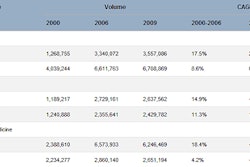
President Obama's recent budget proposal for 2013 calls for the U.S. Centers for Medicare and Medicaid Services (CMS) to institute a mandatory prior authorization program for advanced imaging services -- CT, MRI, and PET -- as part of a package of benefit, payment, and quality reforms designed to improve the appropriateness, quality, safety, and financial sustainability of the Medicare system. The president's proposal follows the near-unanimous recommendation by the Medicare Payment Advisory Commission (MedPAC) in April 2011, and a similar recommendation by the Blue Cross/Blue Shield Association (BCBSA) in September 2011, and targets to save Medicare nearly $5 billion over the next decade.
Real opportunity
An abundance of peer-reviewed research exists documenting ordering practices and market dynamics that result in imaging that is either inappropriate or of questionable clinical value. According to these studies, imaging inappropriateness estimates range anywhere from 10% to 20%, and in certain studies for certain imaging exam types, as high as 30% to 40%. At an average cost per test of $500 to $700 for Medicare members, the costs of inappropriate imaging are staggering -- not even including the costs of lost time or productivity for patients/employees, employers, and providers. The costs documented for inappropriate imaging also fail to account for unnecessary downstream or follow-up procedures normally associated with initial imaging.
A recent study by Milliman -- a leading independent professional actuarial firm -- projects that radiology benefits management (RBM) programs have the potential to save $13 billion to $24 billion in federal budget expenditures and patient cost-sharing over a 10-year period by leveraging the same programs already used by the majority of commercial health plans today.
Proven value
At their core, RBM programs are designed to collect relevant clinical information regarding a proposed advanced imaging procedure for each patient, and compare the information against widely accepted clinical guidelines. If the exam ordered fails to meet guidelines, RBMs educate the ordering physician on more appropriate alternatives and, if necessary, deny approval for payment to prevent unnecessary services from being delivered.
Today, more than 100 million commercial health plan members are covered under RBM programs, saving more than $2.5 billion annually because their health benefits plans have implemented RBM programs.
These savings are achieved solely by ensuring that only those imaging services that meet appropriateness criteria, issued by professional medical societies (led by many of the nation's leading physicians) and supported by evidence-based research, are performed and reimbursed.
Through industry innovations, these programs have become an efficient and effective way to ensure the clinical appropriateness of advanced imaging procedures prior to the services being performed. For example, more than 60% of imaging requests received by American Imaging Management (AIM), a provider of RBM programs, occur over the Web, and the average time to authorize a clinically appropriate exam is less than five minutes. Only when physician orders fail to meet clinical guidelines is an educational physician-to-physician discussion necessary to resolve the case. The majority of those physician interactions result in a voluntary withdrawal of the original order or a change to the more appropriate exam.
Health plans, like those working with AIM, have achieved and are sustaining a 10% to 20% utilization advantage over unmanaged populations, proving their ability to reduce inappropriate utilization of outpatient imaging services and prevent unnecessary radiation exposure for patients. These programs ensure that patients receive the right test at the right time and at the right place -- ultimately resulting in significant cost savings, improved efficiency, and increased patient safety.
Adopting similar programs for Medicare and Medicaid members promises to drive significant reductions in government spending, while maintaining physician reimbursement and patient access to valuable clinical services.
Alternative management approaches are suspect
Simply reducing reimbursement for imaging services by Medicare has the potential for unintended consequences. While it may initially reduce government spending and per-unit cost, a November 2011 study from the health policy research department at the American College of Radiology demonstrated that some physicians have countered unit price decreases by increasing self-referral volume.
Additionally, reimbursement cuts have been cited by many physician groups as one of several key factors driving them to consolidate or to join hospital-based groups. Provider consolidation generally drives up unit cost as providers join more expensive hospital-based cost structures, and it reduces the number of high-quality, low-cost provider alternatives for healthcare consumers, effectively eliminating natural competition in the market.
Lowering Medicare reimbursement levels has also been proved to shift some of the cost burden to private payors, especially as providers increase reimbursement rates for commercial payors in an effort to remain budget-neutral.
The mechanics and data collected through RBM programs offer health plans an opportunity to reward physicians for delivering clinically appropriate care through innovative reimbursement and incentive strategies, as opposed to universal cuts that negatively impact all providers.
Some providers argue that prior-authorization programs interfere with the physician-patient relationship, and that provider self-governance via educational decision-support systems is a better alternative.
However, data supporting that provider self-governance programs are equal or superior to RBMs are severely limited. Isolated and experimental self-governance programs, within highly organized provider institutions, have been shown to impact utilization trends somewhat, but decision-support programs generally lack sustained consistency and accountability as they are not tied to reimbursement or other consequences for adherence.
Ironically, in those studies where utilization improvement has been measured for providers with decision-support systems in place, health plans in the same markets produced utilization improvements in excess of the improvements measured by the providers through RBM programs.
Furthermore, RBM programs implemented at the payor level cover millions of patients across broad geographies more consistently and with fewer required implementations. Alternatively, provider decision-support systems would require hundreds of individual implementations even within one state and may result in inconsistent application of clinical guidelines.
A recent article by Dr. Ramin Khorasani, from Brigham and Women's Hospital and Harvard Medical School's department of radiology, and a leader in the development of clinical decision support, highlighted the key shortcomings in the use of provider self-governance tools: "Consequences for ignoring decision support are necessary for it to be effective. Education is a weak tool to change physician behavior. If physicians can simply ignore decision support, they frequently will," he said.
He goes on to suggest that some form of intervention or a consultation with another physician should be included to increase the impact of provider self-governance programs.
Physician consultation as a key component of clinical decision support is precisely the value that has been proved by RBM programs over provider self-governance models.
Other medical imaging industry lobbying groups claim that RBMs negatively affect health outcomes and lead to more healthcare spending. In fact, prior authorization programs not only help to lower cost for medical imaging, they also reduce the cost to society as employees don't lose productive time for undergoing unnecessary imaging tests.
Through clinical appropriateness review, RBMs also identify duplicative or even potentially harmful exams across different providers. Inappropriate imaging studies that lead to questionable findings or false-positive diagnoses can result in unnecessary, costly downstream tests and procedures that could potentially be harmful to patients while also driving up societal costs.
Clinical appropriateness and affordability: A better alternative
With the proposal for Medicare to adopt prior authorization comes a better alternative -- the ability for both physicians and payors to leverage evidence-based medicine in facilitating safer, more appropriate care for all patients. RBM programs have consistently proved their success across commercial and Medicare Advantage populations -- generating tremendous cost-of-care savings while also enhancing the quality and safety of patient care.
Implementing similar programs in partnership with CMS would help to reduce medical costs significantly for America's senior population, ensuring the affordability and the long-term sustainability of Medicare benefits for our growing senior population.



















